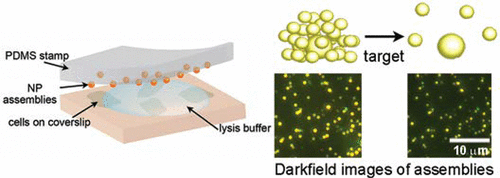Our official English website, www.x-mol.net, welcomes your
feedback! (Note: you will need to create a separate account there.)
Tuning the Sensing Performance of Multilayer Plasmonic Core–Satellite Assemblies for Rapid Detection of Targets from Lysed Cells
ACS Sensors ( IF 8.2 ) Pub Date : 2017-11-15 00:00:00 , DOI: 10.1021/acssensors.7b00566 Nguyen Hoang Le 1 , Bach Kim Nguyen 1 , Gang Ye 1 , Chun Peng 1 , Jennifer I. L. Chen 1
ACS Sensors ( IF 8.2 ) Pub Date : 2017-11-15 00:00:00 , DOI: 10.1021/acssensors.7b00566 Nguyen Hoang Le 1 , Bach Kim Nguyen 1 , Gang Ye 1 , Chun Peng 1 , Jennifer I. L. Chen 1
Affiliation

|
Optical sensors based on discrete plasmonic nanostructures are invaluable for probing biomolecular interactions when applied as plasmonic rulers or reconfigurable multinanoparticle assemblies. However, their adaptation as a versatile sensing platform is limited by the research-grade instrumentation required for single-nanostructure imaging and/or spectroscopy and complex data fitting and analysis. Additionally, the dynamic range is often too narrow for the quantitative analysis of targets of interest in biodiagnostics, food safety, or environmental monitoring. Herein we present plasmonic assembly comprising a core nanoparticle surrounded by multiple layers of satellite nanoparticles through aptamer linker. The layer-by-layer assembly of the satellite nanoparticles yields uniform discrete nanoparticle clusters on a substrate with enhanced optical properties. Binding of the model target (adenosine 5′-triphosphate, ATP) induces disassembly and leads to a dramatic decrease in the scattering intensity that can be analyzed readily from darkfield images. We demonstrate that the sensing performance, such as detection limit, dynamic range, and sensitivity, can be tuned by controlling the size of the assembly. The substrate-anchored nanoparticle assemblies are selective to only ATP, and not other adenine-containing compounds. By adapting the methodology to a flexible support, cellular ATP can be directly detected by lysing adherent cells in close contact with the plasmonic assemblies—a process that does not require any sample preparation or purification. Enhancing the optical detection signal via designing and engineering nanoparticle assemblies could enable their use with low-cost portable imaging systems and broaden their applicability beyond the study of biomolecular interaction.
中文翻译:

调整多层等离子核心-卫星组件的传感性能,以快速检测裂解细胞中的靶标
当用作等离子尺或可重构多纳米粒子组件时,基于离散等离子纳米结构的光学传感器对于探测生物分子相互作用具有不可估量的价值。但是,它们作为通用传感平台的适应性受到单纳米结构成像和/或光谱学以及复杂数据拟合和分析所需的研究级仪器的限制。此外,动态范围通常太窄,无法对生物诊断,食品安全或环境监测中感兴趣的目标进行定量分析。在本文中,我们提出了等离子体组装,其包括通过适配子接头被多层卫星纳米颗粒包围的核心纳米颗粒。卫星纳米颗粒的逐层组装在具有增强的光学性能的基底上产生均匀的离散纳米颗粒簇。模型目标(腺苷5'-三磷酸腺苷,ATP)的结合会引起分解,并导致散射强度显着降低,可以很容易地从暗场图像中进行分析。我们证明了可以通过控制组件的大小来调整检测性能,例如检测极限,动态范围和灵敏度。底物锚定的纳米颗粒组件仅对ATP具有选择性,对其他含腺嘌呤的化合物不具有选择性。通过使方法适应灵活的支持,可以通过裂解与等离子体组件紧密接触的贴壁细胞来直接检测细胞ATP,此过程无需任何样品制备或纯化。
更新日期:2017-11-15
中文翻译:

调整多层等离子核心-卫星组件的传感性能,以快速检测裂解细胞中的靶标
当用作等离子尺或可重构多纳米粒子组件时,基于离散等离子纳米结构的光学传感器对于探测生物分子相互作用具有不可估量的价值。但是,它们作为通用传感平台的适应性受到单纳米结构成像和/或光谱学以及复杂数据拟合和分析所需的研究级仪器的限制。此外,动态范围通常太窄,无法对生物诊断,食品安全或环境监测中感兴趣的目标进行定量分析。在本文中,我们提出了等离子体组装,其包括通过适配子接头被多层卫星纳米颗粒包围的核心纳米颗粒。卫星纳米颗粒的逐层组装在具有增强的光学性能的基底上产生均匀的离散纳米颗粒簇。模型目标(腺苷5'-三磷酸腺苷,ATP)的结合会引起分解,并导致散射强度显着降低,可以很容易地从暗场图像中进行分析。我们证明了可以通过控制组件的大小来调整检测性能,例如检测极限,动态范围和灵敏度。底物锚定的纳米颗粒组件仅对ATP具有选择性,对其他含腺嘌呤的化合物不具有选择性。通过使方法适应灵活的支持,可以通过裂解与等离子体组件紧密接触的贴壁细胞来直接检测细胞ATP,此过程无需任何样品制备或纯化。











































 京公网安备 11010802027423号
京公网安备 11010802027423号